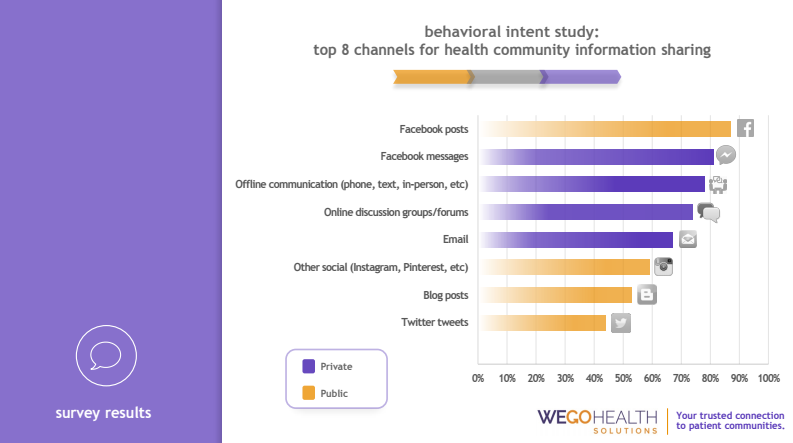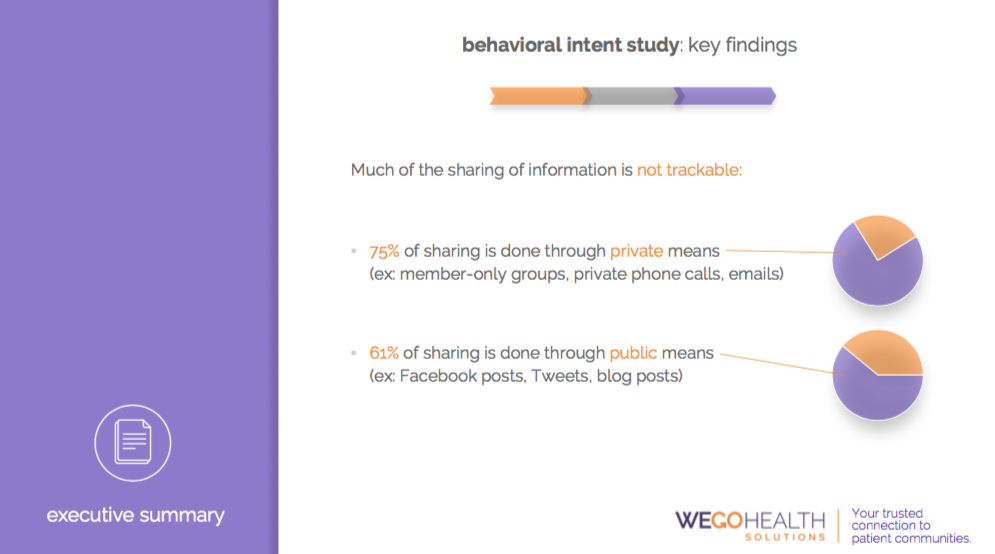The Secret Life of Health Information

 (Image Source: Pixabay)
(Image Source: Pixabay)
The Secret Life of Health Information
By Laurel Netolicky, VP, Business Development, WEGO Health
We know that health and its related issues are discussed online every day. And yet the depth and influence of these conversations are not apparent to the casual observer. To understand the impact of these discussions we need to dig down a bit and look at how people use social media to seek out and share health information online.
Social Networks Influence Health Decisions
Pew Research was among the first to document how social networks influence people’s health decisions in its cornerstone, multi-year study The Social Life of Health Information.
In 2009 Pew reported that 61% of American adults were looking online for health information. Of those, 60% said the information they found online influenced their treatment decisions and 56% were influenced to make changes to their overall approach to health.
By 2011 Pew reported that the percentage of Internet users who looked online for health information had grown to 80% with 18% of them specifically seeking out people with health concerns similar to theirs.
In its 2016 study, Social Media for Health: What Socially-Active Patients Really Want, Health Union found that 81% of patients look at online resources to learn about medication or treatment options. Of these, 73% said that the information they found online had at least some impact on their health decisions.
Now WEGO Health, in its Behavioral Intent Study, finds that an astonishing 91% of patients surveyed say that online communities play a role in their health decisions.
Patient Peers as a Source of Information
The advent of patient peers on social networks has taken the social life of health information to new levels.
Both Pew and Health Union found that patient peers are willing to share their own experiences in order to help others. The combination of this willingness and the rise of social networks has made patient peers more accessible and their personal experiences widely available.
Health Union reported that 63% of patients online are looking for people living with the same health condition as they are. In this same group, 62% went online to find people who understood what the patient experiences when dealing with their same health conditions.
The information people value most from patient peers centers on emotional support and finding quick remedies for everyday health issues. According to Pew people still looked to medical professionals for information about diagnosis, treatments, and prescription drugs.
Even with their expanded role online, patient peers don’t replace medical professionals as trusted sources of health information. Patient peers provide real-life, been-there-done-that experience, supplementing the information provided by medical professionals.
AnneMarie Ciccarella, Breast Cancer and Mental Health Health Patient Leader, speaks to this in a WEGO Health market research study:
"The folks that are seeking advice know who they can rely on and count on for getting accurate information. They generally seek those people (Patient Leaders and peers) that help frame the questions, and once they’re armed with the questions they have more confidence to go and discuss things with their doctors."
 (Image Source: WEGO Health)
(Image Source: WEGO Health)
Social Media as an Important Channel of Communication
There are many ways people can access health information online, from condition-specific blogs and discussion groups to tweets and direct messages.
WEGO Health identified the eight most popular communication channels among patients. They are, in descending order of use:
- Facebook posts
- Facebook messages
- Offline communications (phone, text, in-person, etc.)
- Online discussion groups and forums
- Other social channels (e.g., Instagram, Pinterest, etc.)
- Blog posts
- Twitter tweets
Facebook was reported as the most popular and most often accessed online community among patients looking for and sharing health information online by both WEGO Health and Health Union.
WEGO Health found that Facebook posts ranked first and Facebook messages ranked second among top communications channels. Health Union reported that 52% of its survey respondents consulted Facebook at least once a month for health information.
Interestingly, online communications have not completely replaced communications in real life. Phone calls, text messages, and in-person meetups, as a group, ranked third among the top communications channels.
Private Channels Keep Health Information Largely Invisible
Even with so much activity online very little of the health information exchanged between patient peers is visible online. A substantial amount of what is being shared is being shared privately and cannot be easily accessed or tracked.
WEGO Health found that more patients share health information privately (75%) than publicly (61%).
 (Image Source: WEGO Health)
(Image Source: WEGO Health)
Half of the top communication channels it identified are private. Other than Facebook posts, which can be configured to limit visibility to group members, the top five communications channels are all private.
Considering that people are looking for emotional support and people who understand the patient experience, it’s not surprising that so must sharing of health information online happens behind privacy walls. People are at their most vulnerable when seeking emotional support and for many health issues can be embarrassing.
The Secret Life of Health Information Continues
We can expect people to continue seeking out and sharing health information online. It’s proven to be a valuable in making health decisions and Internet access has become ubiquitous. However, for those outside the circle of patient peers, these conversations will remain for the most part invisible.
Laurel Netolicky has been in the digital and social media space for over 15 years, and she specializes in forming sincere and productive relationships. Everyday at WEGO Health, she works to create collaborative connections between patient community leaders and healthcare businesses while continuing WEGO Health’s growth as a caring and informative company. Laurel spends her free time as an avid runner, boater, cook and mom to her twins.
